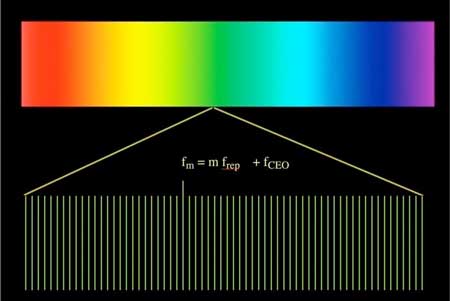| Mar 07, 2019 | |
Combs of light for molecules(Nanowerk News) Atoms and molecules are the building blocks of matter. Spectroscopy can detect and identify a wide range of different compounds by their characteristic fingerprint-like absorption of radiation. Applications range from basic studies of molecular structure and dynamics to industrial process control, environmental monitoring and medical diagnostics. |
|
| In recent years, powerful and potentially game-changing new tools for spectroscopy have emerged, based on mode-locked ultrafast lasers and their broad combs of evenly spaced sharp spectral lines. | |
| A review article in Nature Photonics ("Frequency comb spectroscopy") by Nathalie Picqué and Theodor W. Hänsch discusses developments and prospects in the emerging and quickly advancing field of atomic and molecular broadband spectroscopy with frequency combs. | |
 |
|
| Figure 1: A frequency comb is a spectrum that spans a broad spectral bandwidth. It is composed of thousands or millions of phase-coherent sharp laser lines that are evenly spaced. (Image: MPQ) | |
| A frequency comb (Figure 1) is a spectrum of phase-coherent sharp laser lines that are evenly spaced. Such combs based on femtosecond mode-locked lasers, as pioneered at the Max-Planck Institute of Quantum Optics in the 1990s, have revolutionized measurements of frequency and time. | |
| In frequency metrology, a laser comb acts as a ruler in frequency space, that conveniently links microwave and optical frequencies, and/or measures a large separation between two optical frequencies. In the past decade, frequency combs have found new applications. | |
| One of these is frequency comb spectroscopy: spectroscopy where the comb is used to directly excite or interrogate a sample. Molecular spectroscopy with frequency combs offers particularly intriguing opportunities, since complex spectra can be interrogated simultaneously by a large number of comb lines over a broad spectral range. | |
| Frequency combs bring a set of new tools to spectroscopy in all phases of matter. The past decade has witnessed remarkable progress in laser frequency comb generators dedicated to broadband spectroscopy, especially in the molecular-fingerprint mid-infrared (2–20 µm) region and the ultraviolet range (<400 nm). | |
| Such synthesizers harness modern tools of laser physics and nonlinear optics technology: mode-locked lasers, nonlinear frequency conversion, microresonators, electro-optic modulators, semi-conductor lasers etc. Existing spectrometers and spectrometric techniques have been adapted and improved to make the most of such sources, while entirely new comb-enabled approaches and instruments have been explored. | |
| The new features enabled by frequency comb spectroscopy hold much promise for a vast number of applications ranging from fundamental physics to optical sensing. For instance, chip-scale frequency comb spectrometers may lead to integrated devices for chemical and biomedical sensing in real time. |
| Source: Max-Planck-Institut für Quantenoptik | |
|
Subscribe to a free copy of one of our daily Nanowerk Newsletter Email Digests with a compilation of all of the day's news. |
